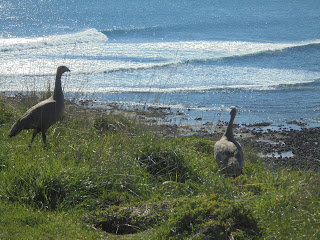The group divided into two: those who had visited Christmas before and those who hadn't. This was my fifth trip to Christmas Island, so I fell comfortably into the first group. We drove around the island and were shocked to see how very dry it was. Richard had warned us that things were dry, but hearing about it and actually witnessing it were two different things. Finding new birds in these conditions was going to be difficult.
 |
| There were many more Island Thrushes than on my previous visits. |
There has been a concerted effort to remove feral cats from Christmas Island and we saw several cat traps on our travels. This is paying off. I saw just two cats on the island - both of them domestic moggies in the township of Settlement. More noticeable was the increased population of Island Thrushes. They were abundant, and I'm sure this is a direct result of the cat eradication program.
 |
| Cat Trap |
Kestrels and Christmas Imperial Pigeons were always abundant. Other birds we saw every day were Christmas Island Swiftlets, White-tailed Tropicbirds (including Golden Bosunbirds), Red-footed Boobies, Great Frigatebirds and Christmas Frigatebirds. Alas, the Red-billed Tropicbird I had searched for on my previous visit was no longer present.
 |
| The poinceanas were looking beautiful. |
The poinceanas were in flower and looking beautiful. The red crabs were migrating. Many roads were closed and some were open that should have been closed. On several occasions we had a few spots of rain, but not enough to get properly wet, and certainly not enough to satisfy the rainforest.
At Swift Alley we enjoyed lots of Abbott's Boobies, but no swifts. On the road to Dolly's Beach, white-eyes, thrushes and Common Emerald Doves enjoyed pools of water on the road, provided by a natural spring. We visited the farm, hoping to see the Yellow Bittern that was present a fortnight ago, but it was nowhere to be seen.
We went spotlighting a couple of times, first to see the endemic boobook, then looking for nightjars. We saw the Christmas Boobook, but there was no hint of nightjars. My one hope for a lifer on Christmas had been a Savanna Nightjar, which I had heard calling on two separate occasions on previous visits. It was not to be.
I saw Yellow Crazy Ants on the handrail at Margaret Knoll. Millions of dollars have been spent trying to eradicate these pests, and it is unclear whether or not the program will be successful. The ants were introduced from South America, arriving early in the twentieth century, and were not a major threat for some decades. Then, for some reason, they formed supercolonies, and immediately became a major problem, killing red crabs and destroying the environment. The national parks experts are attempting a biological control of the ants, using a tiny wasp that destroys the ant's main food source, an introduced scale. Let's hope it works.
Rob and I attended a fascinating talk about the captive breeding program for two lizards, both extinct in the wild. One was the Blue-tailed Skink and the other Lister's Ghecko. The idea is to breed them up in sufficient numbers to re-introduce them to their former home.
Although this was my fifth visit to Christmas Island, I did two things I've never done before: I walked to the Dales (which was lovely) and I took a boat trip around the island (which was most enjoyable). The boat trip was predominantly organized for snorklers, but I admired the scenery and the birds and certainly got my money's worth.
Despite being so dry, the island is always a very special place. The rainforest is serene, the frigatebirds are mesmerizing and the crabs are fascinating. It's sad to see the casino deserted. I will have to go back. Apart from anything else, I have an appointment with a Savanna Nightjar.



































